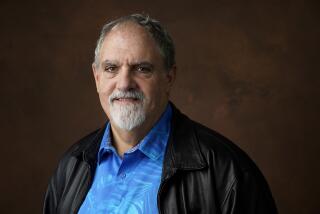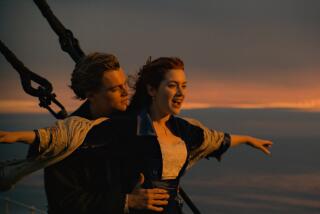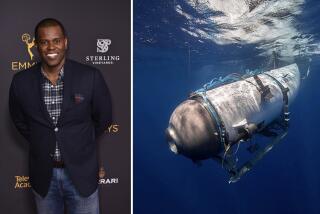Walter Lord, 84; Wrote ‘A Night to Remember’ on Sinking of Titanic
- Share via
Walter Lord, pioneering author who popularized a “you are there” documentary approach to history that twice landed his seminal work, “A Night to Remember,” about the sinking of the Titanic, on the bestseller list, has died. He was 84.
Lord died Sunday at his New York City home after a long struggle with Parkinson’s disease. He had been using a wheelchair for several years.
The collision of the most luxurious and biggest ship yet built with an iceberg in the North Atlantic on April 14, 1912, and the subsequent disaster that cost more than 1,500 lives have been the subject of half a dozen films, several plays, an opera, a musical and more than 100 books, songs and poems.
Lord happened on one of those books when he was 10 and grew up to write the definitive volume that restored the tragedy to the cultural memory after it had been all but forgotten through two world wars.
His “A Night to Remember,” published in 1955, has never been out of print.
It became a bestseller immediately upon publication and again in 1998 in the mania sparked by James Cameron’s film “Titanic,” on which Lord served as advisor.
When Cameron accepted two of the film’s 11 awards, for best picture and directing, he called the Oscar ceremony “a night to remember” alluding to Lord’s book.
“It was such a remarkable story,” Lord told The Times in 1986, as intrigued as ever with the ship whose remains had been discovered on the ocean floor by Robert D. Ballard and his mini-submarine Alvin.
“It was the largest ship, the biggest thing man had ever built, the most luxurious ship, proclaimed unsinkable, filled with the most glamorous people of the age, sinking on its first voyage, taking 1,500 lives. Who could believe it?”
The slim book the boy found in his aunt’s Maryland home in 1927 was one of the first published about the disaster: “The Loss of the S.S. Titanic” by an English science teacher who had been a passenger aboard the “unsinkable” White Star liner.
“I was hooked,” Lord told the Baltimore Sun four years ago, brandishing the little volume he had kept for 70 years. “This is the book that caused all of the trouble.”
Obsessed, Lord, the son of a Baltimore lawyer, drew pictures of the Titanic in his preppy days, and for his senior speech offered an evocative and vivid account of the ship’s sinking that gave several classmates nightmares.
Lord studied American and modern European history at Princeton and then attended Yale Law School until World War II intervened, sending him to the Office of Strategic Services to assemble intelligence reports.
He completed his law degree after the war but instead of practicing, became a copywriter for the J. Walter Thompson advertising agency, touting after-shave lotion, trucks and beer.
His career as an author began with the same kind of opportune discovery as his fascination with the sinking of the Titanic.
In a Manhattan bookstore, the young adman chanced upon an 1874 diary of a British officer who fought for the Confederacy during the Civil War. Lord bought the diary for $2, edited it and republished it with the title “The Freemantle Diary.”
An editor and friend soon suggested that Lord turn his absorption with the Titanic into a book of his own. Lord began work on what he considered “the most exciting news story that ever happened.”
His approach, now commonplace, was unusual half a century ago.
He tracked down 63 of the Titanic passengers and, like a reporter covering some up-to-the-minute tragedy, interviewed them about what he called “a night of horror that those who survived it would never forget.”
Lord not only revived the Titanic disaster and gave it a new status in history, but he also launched a technique of telling history through the eyes of those who lived it.
“History is a wonderful guide to human behavior,” Lord told Contemporary Authors, “and that is why people fascinate me so much. If we study them carefully enough, maybe next time we’ll be able to recognize just a little bit sooner a hero or a villain, a leader or a knave.... In ‘A Night to Remember’ I tried to get across the point that wealth, position, rank and the like have very little to do with whether a person is good or bad, quick or slow, brave or perhaps not so brave. We get all that somewhere else.”
Lord’s best-known book was made into a British film of the same title in 1958, in a straightforward documentary style without the intervening love story and other subplots of Cameron’s “Titanic.” A 1994 Times review noted that the well-drilled ensemble “reflects the courage, cowardice, foolishness and Edwardian morality of the time with believable accuracy.”
After perfecting his research method--favoring personal interviews or diaries of actual witnesses more than official records and reports--Lord expanded the technique further, even interviewing Japanese pilots for his next book, “Day of Infamy,” about the Japanese attack on Pearl Harbor.
“Interviewing the enemy--nobody had done that before,” Evan Thomas, Lord’s friend and a Newsweek editor, told Associated Press on Monday in announcing Lord’s death.
Lord continued personalizing history with “The Good Years” in 1960, a book about early 20th century America that was made into a television special starring Henry Fonda.
His following books included “A Time to Stand” in 1961, about the Alamo; “Peary to the Pole” in 1963, about the admiral’s exploratory voyage; “The Past That Would Not Die” in 1965, about James Meredith’s integration of the University of Mississippi; “Incredible Victory” in 1967, about the Battle of Midway, which was the turning point in the Pacific during World War II; “The Dawn’s Early Light” in 1972, about the British attacking Baltimore in the War of 1812; “Lonely Vigil” in 1977, about World War II coast watchers in the Pacific; and “The Miracle of Dunkirk” in 1982, about the Allies’ preservative retreat from the Nazis in 1940.
All of Lord’s books became bestsellers, but none were as beloved or remembered as his works on the Titanic.
In 1986, the historian published his final book, a second look at the Titanic, “The Night Lives On.”
In that sequel, he reported what he had learned since writing the first book, including debunking many myths about the big ship’s watery demise.
He disputed, for example, the myth that the band supposedly sank into the water playing “Nearer My God to Thee.”
More likely, he told The Times in 1986, they were playing a popular light waltz because they were trying to cheer up the passengers. And, despite what many like to believe, when the waters rose, he said, they tossed their instruments and ran like everybody else.
Lord befriended many Titanic survivors, and they willed him personal possessions that became greatly prized items in his vast collection of the ship’s memorabilia--such as the embroidered evening slippers worn by the late Edith Russell when she stepped into a lifeboat and the musical pig she used to entertain a surviving child.
Lord’s trove of Titanic memorabilia, including books, paintings, photographs and items that were aboard the sinking ship, will be given to the National Maritime Museum in Greenwich, England.
Lord, who never married, had no immediate survivors.
The New York Historical Society will host a memorial service for him June 10.
More to Read
Only good movies
Get the Indie Focus newsletter, Mark Olsen's weekly guide to the world of cinema.
You may occasionally receive promotional content from the Los Angeles Times.








